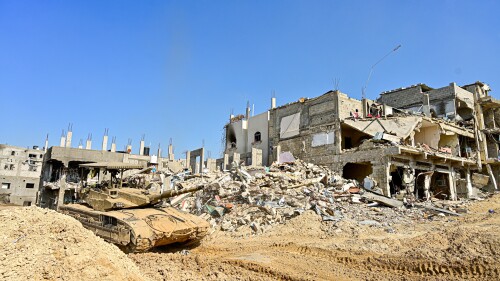Iranian Islamic Revolutionary Guards Corps Col. Hassan Sayad Khodaei was killed in Tehran May 22; two days later his coffin was borne at his funeral. |
The killing of Iranian Islamic Revolutionary Guards Corps (IRGC) Col. Hassan Sayad Khodaei outside his home in Tehran on May 22 appears to have manifested a significant shift in Israel’s strategy toward Iran.
In the past, the Jewish state’s alleged efforts on Iranian soil have been directed toward personnel and facilities connected to the Iranian nuclear program. However, Jerusalem now appears to have expanded the scope of its operations against the Islamic Republic.
Khodaei had no known connection to the nuclear program. Instead, he was one of the IRGC-Quds Force’s most seasoned special operations men. Khodaei was a senior commander in the Quds Force’s Unit 840, which is engaged in external operations including kidnappings and assassinations. He also played an essential role in transferring drone and missile technology to Lebanese Hezbollah, Tehran’s key regional proxy. Moreover, according to Hebrew media reports, Khodaei was masterminding a plan to abduct Israelis overseas at the time of his demise.
Khodaei’s killing was the second known operation attributed to Israel on Iranian soil against a target unconnected to Tehran’s nuclear program. The first was a strike at an airbase at Kermanshah in mid-February which decimated Iran’s UAV fleet.
Israeli operations on Iranian soil, famously, are not a rarity. They have in recent years included the theft of the Iranian nuclear archive in 2018, the killing of several scientists associated with the nuclear program and probably also acts of sabotage against nuclear facilities, such as the explosion at the uranium enrichment complex at Natanz in December 2021.
Israel has succeeded in thoroughly penetrating Iran’s defenses.
These actions indicate that Israel has succeeded in thoroughly penetrating Iran’s defenses. More broadly, Israel has in recent years been engaged in a shadow war against Iranian efforts at power-building across the Middle East. Israeli air power has been active in disrupting and damaging Iranian infrastructure in Syria. Individual assassinations have taken place in Syria and probably also in Lebanon. Israeli planes have struck as far afield as Iraq.
Israeli action against Iranian efforts at power projection across the poorly governed spaces of the Levant and Iraq has been frequent. And a campaign on Iranian soil to disrupt nuclear-related activity is long-standing. But the extension of Israel’s campaign against Iran’s non-nuclear subversive activities onto Iranian soil is a new development and a significant escalation.
So what has precipitated this broadening of Israel’s secret war?
Firstly, such a change is not merely tactical, and a decision to adopt it would not have been taken at the professional-operational level. Such operations would need to have received the nod from the prime minister.
The growing perception in Israel in recent years is that the Iranian nuclear program cannot be seen in isolation from Tehran’s broader strategy for regional domination. Outgoing Prime Minister Naftali Bennett has long been vocal in support of this view.
While serving as then-Prime Minister Benjamin Netanyahu’s defense minister in February 2020, Bennett told Israeli reporters, “When the octopus tentacles hit you, you must fight back not just against the tentacles, but also make sure to suffocate the head of the octopus, and the same applies to Iran.”
When the octopus tentacles hit you, you suffocate the head of the octopus.
He added, “For years, we have fought against the Iranian tentacles in Lebanon, Syria and the Gaza Strip, but we have not focused enough on weakening Iran itself. So now we are changing the paradigm.”
In June 2020, the Israel Defense Forces (IDF) established the Strategy and Third Circle Directorate, a body tasked with formulating a comprehensive view of the Iranian threat. The Directorate’s express purpose is to avoid compartmentalization of the Iranian threat and instead see all aspects of it as connected.
Now, this approach is being extended to the operational sphere. Israel sees Iran as engaged in a comprehensive, strategic drive intended to result in Tehran’s emergence as the dominant power in the Middle East. The destruction of Israel is a critical element of this strategy.
This project is not led by the employment of conventional armed forces. Instead, it is focused on political and proxy military activity, investment in its ballistic missile program and the development of a nuclear capability as an insurance policy for the other two elements. The Jewish state, in turn, is in the process of formulating and implementing a comprehensive response.
A counter-envelopment of Iran through deepening ties with states surrounding it—including Azerbaijan to the north and the United Arab Emirates, Bahrain and Saudi Arabia to the southwest, form part of this approach. Israel’s transfer to U.S. Central Command (CENTCOM) offers potential for operationalizing these growing links in key areas, such as air defense.
The totality of Iranian actions will now be opposed, including on Iranian soil.
A notable change of the rules of engagement has taken place, in which the totality of Iranian actions will now be opposed, including on Iranian soil. The strike on the UAV fleet at Kermanshah and the assassination of Col. Khodaei in Tehran were the first manifestations of this new approach.
This is not a strategic change in direction for Israel, but a significant broadening of its target bank and perhaps its understanding of the nature of the Iranian challenge.
Some additional suspicious deaths of significant figures within Iran’s national security apparatus have occurred since Khodaei’s death, though none were as senior as him.
With a change of government now a matter of time in Israel, it will be interesting to see if this significant shift is maintained in the period ahead.
Jonathan Spyer is a Ginsburg/Milstein Writing Fellow at the Middle East Forum and director of the Middle East Center for Reporting and Analysis.








